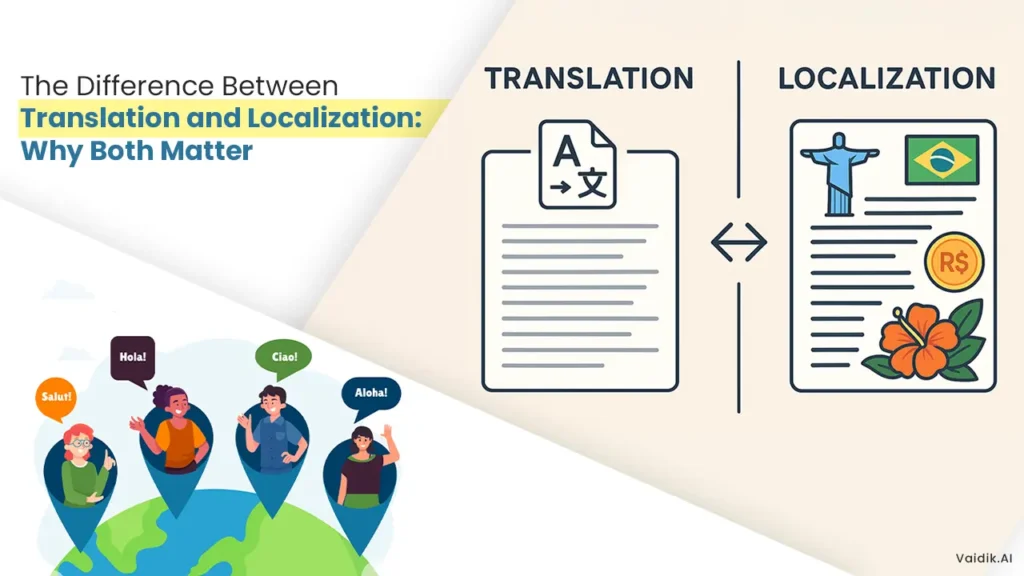In today’s interconnected world, businesses and content creators reach global audiences. Websites, software, mobile apps, and marketing campaigns are shared worldwide. Making content accessible to diverse populations is crucial. Translating content into another language is not always enough. This is where translation and localization are important.
Translation ensures content can be understood in another language. Localization makes content resonate with the target audience. It adapts cultural nuances, legal requirements, and user preferences. Understanding the difference between translation and localization is essential. Both are key for businesses aiming to expand successfully.
What is Translation
Translation is converting text from one language to another while keeping the original meaning. It focuses on linguistic accuracy. It ensures the content is clear and understandable in the target language. Translation is often used for documents, books, articles, manuals, and user guides.
The Different Types of Translations include:
- Literal Translation: This is word-for-word translation. It keeps the exact wording but may not fit cultural or contextual needs.
- Semantic Translation: This focuses on the intended meaning instead of the exact words.
- Technical Translation: This deals with specialized terms for fields like medicine, law, or science.
- Machine Translation: Automated tools like Google Translate perform this. These tools are improving but still need human review for accuracy.
Translation Services is essential for businesses. This is important as it can break language barriers. However, word-for-word translation may fail to connect with diverse audiences. This is where localization becomes important.
What is Localization
Localization adapts content to fit a specific culture, region, or audience. It goes beyond translation by considering cultural and regional differences. It modifies idioms, currency, date formats, images, humor, and even product packaging. This ensures the content aligns with local expectations and customs.
Important Features of Localization Are:
- Cultural Sensitivity: Ensuring symbols, colors, images, and gestures are appropriate and meaningful for the target audience.
- Legal And Regulatory Compliance: Adapting content to follow local privacy laws, advertising rules, and other regulations.
- Formatting And Design: Changing date formats, number systems, currency symbols, and measurement units to match local conventions.
- User Experience (UX) Customization: Adjusting interfaces, navigation, and customer service to suit the habits and preferences of the audience.
Localization ensures content not only conveys a message but also connects and engages with the local market. It is crucial for brands aiming to establish a strong global presence and build deeper connections with their audience.
Key Differences Between Translation And Localization
Feature | Translation | Localization |
Purpose | Converts text from one language to another | Adapts content for cultural and regional relevance |
Scope | Focuses on linguistic accuracy | Includes cultural, legal, and user experience modifications |
Process | Word-for-word or meaning-based conversion | Customization of visuals, design, and context |
Audience Impact | Makes content understandable | Make content relatable and engaging |
Examples | Technical documents, books, academic papers | Websites, apps, games, marketing campaigns |
Why Both Translation And Localization Matter
To reach a global audience, translation alone is not enough. A well-translated message can fail if it ignores cultural expectations. Similarly, localized content without accurate translation can cause misunderstandings. Both are essential for success. The features of both are:
- Ensures Better Communication
- Translation breaks language barriers. It makes information accessible.
- Localization ensures the content fits the cultural and social context.
- Enhances User Experience:
- Users connect better with content that feels familiar and native.
- Localization builds trust by using relatable terms, visuals, and formats.
- Avoids Cultural And Legal issues
- Poor translation or lack of localization can cause misunderstandings. Adapting content to local laws prevents compliance problems.
- Both translation and localization are vital for effective communication, user satisfaction, and global success.
Conclusion
In today’s global marketplace, businesses must go beyond simple translation to truly connect with audiences worldwide. While translation ensures content is understood across languages, localization adapts that content to align with cultural, legal, and regional expectations. Both play a critical role in building trust, improving user experience, and ensuring compliance. Companies that combine accurate translation with effective localization are better positioned to expand globally, resonate with their target markets, and achieve sustainable growth.
Categories
Frequently Asked Questions
Translation focuses on converting text from one language to another while maintaining meaning, whereas localization adapts the content to cultural, regional, and user-specific contexts.
Localization ensures that content resonates with local audiences by considering cultural nuances, legal requirements, and user preferences, making businesses more relatable and trustworthy.
Yes. Even small businesses targeting international customers benefit from combining translation and localization to improve communication, avoid misunderstandings, and create stronger customer connections.
